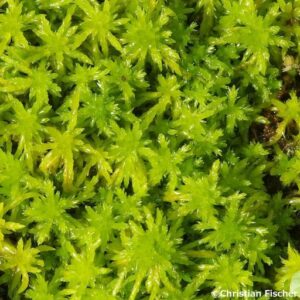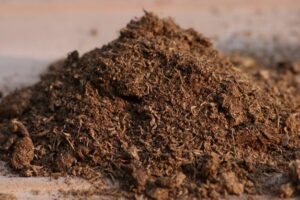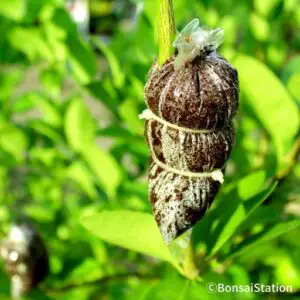Sphagnum moss is used in bonsai as anti-drying agent, to improve soil aeration, and to improve soil nutrient retention. Caution has to be taken against its capabilities to retain very high amount of water as well as to acidify the soil.
Sphagnum moss vs. peat moss: the difference
Before diving into sphagnum moss and bonsai, here are the differences between sphagnum moss and peat moss.
Sphagnum moss vs. peat moss vs peat
In short,
- Sphagnum moss is species of moss in Sphagnum Genus.
- Peat is an accumulation of partially decayed vegetation or organic matter, not exclusively sphagnum mosses but others like coconuts can be included. Coco peat is coconut fiber extracted from the outer husk of coconut.
- Peat moss is an organic substance corroded usually by sphagnum moss. The word, peat moss, is sometimes used interchangeably with other kinds of peat like coco coir peat.
Sphagnum moss
(Source: Wikipedia)
What is it?
Sphagnum is a genus of mosses found all over the world both in the northern and southern hemispheres. There is disagreement as to how many species of Sphagnum moss there actually are, but most authorities recognize approximately 120 around the world.
Characteristic: 1
Sphagnum mosses are found exclusively in wet habitats. They possess special water retaining cells, called hyaline cells, which soak up water and release it slowly. The hyaline cells allow sphagnum to hold over 20 times its dry weight in water. This means their habitat is kept constantly wet and moist.
Characteristics: 2
Sphagnum mosses also actively acidify the habitat they live within by producing special acidic chemicals and adding hydrogen ions; this prevents other plants, which cannot tolerate such conditions, from growing.
Sphagnum mosses thus are very acidic, alive or dead, with pH of 4.2 to 4.8 depending on where the specimen is taken.
Peat moss
(Souce: Wikipedia)
Peat moss is an organic substance corroded by sphagnum moss and has a pH of 3.0 to 4.0.
Peat moss contains many micropores within it, making it retain water at a high capacity, approximately 20 times as much water as the standard among dry weight. Peat moss thus has been widely used to improve air permeability and water retention.
It is often used to alter soil towards more acid as well for plants like blueberries, which require soil with a pH of 4.5–5.2 and high organic matter content
Is sphagnum moss good for bonsai?
There are several ways in which sphagnum moss is used in bonsai, including
- as anti-drying agent
- to improve aeration, and
- to improve nutrient retention.
Major usage of sphagnum moss in bonsai
As anti-drying agent
Sphagnum moss will keep water longer in the soil if you mix a small amount that has absorbed enough water. Taking advantage of this characteristic, sphagnum moss is used when grafting, harvesting from nature (“yamadori”), and air layering as an anti-drying agent.
To use sphagnum moss as an anti-drying agent, wrap the parts you can to be hydrated with the moss and water it regularly. Or wrap around the moss with a plastic bag so that the humidity is kept inside the moss.
It is also used to cover the exposed roots of bonsai on rock or sometimes on the soil after pruning roots drastically.
How to use sphagnum moss after repotting
Place sphagnum moss on the soil to keep the roots from drying out when repotting in spring.
When reporting, you might have to cut back quite a large portion of the root system. Pruned roots, of course, do not absorb water and the bonsai tree cannot store water much before the new root system has fully grown. If the bonsai tree lacks water during this period, it will be greatly damaged.
To avoid water shortage, leave the sphagnum moss on the surface of the soil lightly. Just cover the area where you pruned the roots heavily. You do not have to cover all the soil surfaces, which might keep the soil too moist all the time. By doing this, you will not need to worry about running out of water.
Mixing a little bit of sphagnum moss with the soil might be a good idea for acid-loving bonsai species such as azalea.
Keep the sphagnum moss on the surface of the soil until the end of summer. If you repot in spring, it will be hot in summer before roots have fully grown, depending on the region. Once the root system grows back, you can remove the sphagnum moss. Bonsai trees can withstand water shortages to some extent at this time, with new roots appearing after root pruning.
To improve aeration
Sphagnum moss is porous and can retain a large amount of air. When mixed with soil, it moderates sudden changes in humidity, warms the roots well, and encourages the development of fine roots.
However, sphagnum moss’s highly acidic nature makes it difficult to be used as a general agent to improve aeration. Its usage is rather limited to acid-loving bonsai species such as azalea.
When mixing with bonsai soil, rub dry sphagnum moss strongly against the sieve and break it into small pieces. Mixing a small amount is the key; a higher amount makes the soil too water retentive for most of the bonsai trees. A good bonsai soil mix aims for high aeration and water retention but not water retention.
To improve nutrient retention
Although sphagnum moss does not contain many nutrients in itself, it can absorb nutrients well and once it absorbs plenty, it will not let go of it easily. But again, sphagnum moss is not for all bonsai species because of its high acidity.
Can sphagnum moss be used as bonsai moss?
Sphagnum moss is not suitable as bonsai moss because it retains too much water, makes the soil acid, and lacks the features necessary for good bonsai moss.
Retain too much water
Mosses need constant moisture. They may avoid dry areas and live in wetlands or become dormant when it is not wet enough. Sphagnum moss is different in this matter in that they can actively control the environment in which they live so that it remains wet enough for them.
Sphagnum moss has special water retaining cells, unlike other mosses, which soak up water and release it slowly. This means its habitat is kept wet and moist all the time. Although this is desirable for mosses, it is not for bonsai trees. Bonsai trees need moisture in the soil but the soil has to drain water well so that air can penetrate for the roots to respirate.
Plant roots need oxygen to burn carbohydrates for the energy to grow and repair. In fact, the main purposes of the drainage holes in the bonsai pot are to prevent the tree from drowning in water and help the soil aerate.
Sphagnum moss can block the bonsai roots to aerate by constantly retaining moisture around them.
For more about root respiration, please read the following post.
Make the soil acid
As mentioned earlier, sphagnum moss actively acidifies the habitat they live within by producing special acidic chemicals and adding hydrogen ions. Most bonsai tree species like mildly acid soil but not heavily acid. Growing sphagnum moss on bonsai soil thus may prevent the trees from growing.
Lack bonsai moss features
Sphagnum moss can grow both horizontally and vertically to grow into a large, fluffy, dense carpet. Sphagnum moss cannot make a good bonsai moss as good bonsai moss has to be small in height and grow together in a lump, not like a carpet. This type of moss that covers the soil like a carpet has to be avoided.
If you want to know more about bonsai moss, the following posts might be helpful.
“The best bonsai moss that looks good on bonsai” (Link here)
—–
Reference
S.K. Rice, “Unique Structure, Physiology and Ecology of Sphagnum“, Encyclopedia of Inland Waters, 2009.
Walker, Mark. (2019). Sphagnum the biology of a habitat manipulator EXTRACT.
Yen, W., Alex Chang, Y., & Wang, Y. (2011). The Acidification of Sphagnum Moss Substrate during Phalaenopsis Cultivation, HortScience horts, 46(7), 1022-1026. Retrieved Aug 21, 2022






